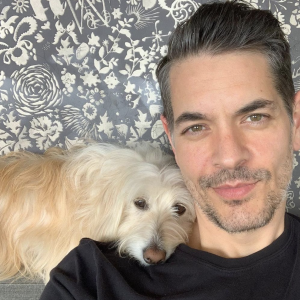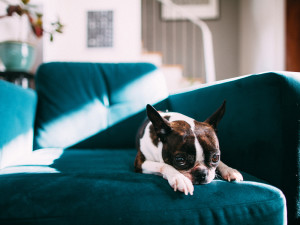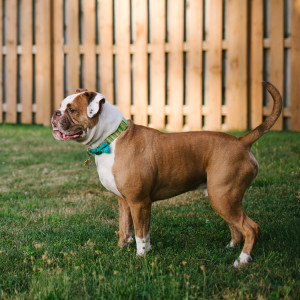“How Do I Get My Dog to Stop Pawing at Things?”
Dog trainer Robert Haussmann’s tips for teaching a pushy pup that there are friendlier ways to get what they want.

share article
Kane is a 22-month-old Cane Corso we brought home in March of 2020 as a puppy. He’s not aggressive, but he’s strong. When he wants in or out, he goes up to the door and hits it with his paw. Not only is it damaging the doors in the house, but he does it to people when he wants them to pet him as well. How can we get him to stop “pawing” at things? We call it his “bam bam” because he just hits anything like a bossy beast. —Jamie
First of all, “bam bam” is adorable. Second, as always, one of the most important things to understand in this situation is your dog’s motivation. The reason he’s doing this is probably because he wanted something, he tried something — pawing — and he got access to something. In this case, I wouldn’t be surprised if it started with a door. He may have learned, “Hey, when I mash this door with my giant paw, it opens and I get to go outside.” Or, “If I start scratching the door, everybody freaks out that I’m scratching the door with my giant paw, and they open it for me.”
It’s hard to ignore a Cane Corso who is pawing at you for attention, but if you give them attention, they learn that their behavior is effective. And if you try to redirect with a boneopens in a new tab or toyopens in a new tab, they learn they’re actually rewarded for bad behavior.
Understanding Motivators and Consequences
We have to look at things from the dog’s perspective. All behavior has three parts. There’s the motivator, which is known as the antecedent. What does the dog want? What is he trying to gain access to or avoid? The second part is the behavior. What does it look like? How often does it happen? How severe is it? And the third part is what the consequence is from the animal’s perspective.
When he paws you, the motivator is attention, the behavior is pawing at you, and the consequence is attention. If the motivation is to go outside, the behavior is pawing the door, and the consequence is the door opening. In both cases, the behavior is reinforced and locked in place. We need the consequence of Kane’s actions to not match his motivator, otherwise there’s no reason for him to stop pawing.
Before we can do any of this, we have to be sure that his needs are met. If he really needs to pee, and we’re not paying attention to him, scratching the door makes plenty of sense. So, we have to make sure that his schedule is set and his needs are fulfilled. Then, if it seems like he just can’t seem to stop the door scratching, you can block him from it or come up with other creative ways to prevent him from being able to engage in the behavior.
Re-Teaching the Consequence
Your best bet is to be proactive here and teach him how to get what he wants. If he’s pawing at you, you can get up and leave. If you come back and he paws again, continue to get up and leave until he stops — then, when you return, and he doesn’t paw, give him all the attention and loving in the world. If he’s pawing at the door, you can potentially give him a time-out there as well, removing his access from the door and then bringing him back to the door with you — maybe even on a leash. Then have him sit or lay down before opening the door for him. This way, he’ll learn that pawing at the door gets him the opposite of the door, but sitting at the door gets the door to open.
Changing the consequence of pawing without adding something scary or painful is important. We want to make sure that, instead of becoming fearful of certain behaviors, he learns a new skill that gives him access to the outside world.
For a while, you may want to require things like sitting, laying down — or even tricks like “handshake”opens in a new tab — before giving him anything he wants, like food or access to furniture. All good things should be filtered through you — not because you’re the dominant alpha dogopens in a new tab, but because you are his teacher and his guide. You have to show him as you guide him: This is how he can gain access to the things he wants in a calm, focused, non-demanding way.

Robert Haussmann, CPDT-KA
Robert Haussman founded Dogboy NYC in 2005 to help pets navigate the urban jungle that is New York City using creative, practical, and humane training methods. Haussmann is a Certified Professional Dog Trainer and Canine Behavior Consultant, specializing in helping dogs overcome behavioral issues including fear, phobias, anxiety, and aggression. He advises owners on the best practices for making their dogs feel safe at home and beyond.
Related articles
![Big dog says hello to a dinner guest sitting at the table]() opens in a new tab
opens in a new tabHow Can I Stop My Dog From Getting Overly Excited When Holiday Guests Arrive?
Expert advice for people with dogs who jump, bark, and generally go nuts when people come over.
![A red haired woman dog trainer kneeling in front of a Shepherd mixed breed dog with one finger raised that the dog is looking at in an outdoor training course.]() opens in a new tab
opens in a new tabUnderstanding Popular Dog Training Methods
Look behind the advertising language when picking a dog trainer.
![Shiba inu dog sitting on kitchen counter in a trailer home]() opens in a new tab
opens in a new tabHow Do I Stop My Dog From Counter Surfing?
Celebrity dog trainer Victoria Stilwell’s pro tips for keeping paws off your charcuterie platter this holiday season.
- opens in a new tab
“How Do I Get My Puppy to Stop Biting My Ankles?”
Dog trainer Robert Haussmann’s tips for dealing with an attention-seeking puppy.





